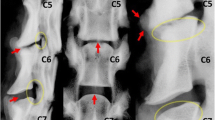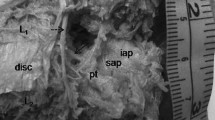Abstract
Introduction
Free disc fragments end often up in the concavity of the anterior epidural space. This space consists of two compartments. The discrepancy between the impressive magnetic resonance imaging findings, clinical symptoms in patients and the problem of treatment options led us to the anatomical determination of anterior epidural space volumes.
Materials and methods
For the first time, the left and right anterior epidural volume between the peridural membrane and the posterior concavity of the lumbar vertebral bodies L3–S1 were determined for each segment. A CT scan and a polyester resin injection were used for the in vitro measurements.
Results
The volumes determined in human cadavers using this method ranged from 0.23 ccm for L3 to 0.34 ccm for L5. The CT concavity volume determination showed this increase in volume from cranial to caudal, as well.
Conclusion
This volume is large enough to hold average-sized slipped discs without causing neurological deficits. A better understanding of the anterior epidural space may allow a better distinction of patient treatment options.


Similar content being viewed by others
References
Bogduk N (1997) Clinical anatomy of the lumbar spine and sacrum, 3rd edn. Churchill Livingstone, London
Crock H (1983) Practice of spinal surgery. Springer, Berlin
Deyo R, Weinstein J (2001) Low back pain. N Engl J Med 344:363–370
Domisse GF (1975) Morphological aspects of the lumbar spine and lumbosacral regions. Orthop Clin North Am 6:163–175
Fick R (1904) Anatomie und Mechanik der Gelenke: 81. Gustav Fischer, Jena
Haro H, Kato T, Komori H, Takahashi M, Shinomiya K (2001) The mechanism of angiogenesis in herniated disc resorption. Abstr Edinburgh ISSLS:13
Hirabayashi S et al (1990) A dorsally displaced free fragment and histologic findings. Spine 15:1231–1233
Hofmann M (1898) Die Befestigung der Dura mater im Wirbelkanal. Arch Anat Physiol 403–412
Hogan Q (1991) Lumbar epidural anatomy. Anaesthesiology 75:767–775
Husemeyer RP, White DC (1980) Topography of the lumbar epidural space. A study in cadavers using injected polyester resin. Anaesthesia 35:7–11
Karpinnen A, Haapea M, Vanharanta H, Tervonen O (2004) Determinants of disc herniation resorption one year follow up. Abstr 252, Porto ISSLS:606
Kato T, Haro H, Komori H, Shinomiya K (2003) The cascade of the spontaneous herniated disc resorption process. Vancouver ISSLS:12
Kawaji Y, Uchiyama S, Yagi E (2001) Three dimensional evaluation of lumbar disc hernia and prediction of absorption by enhanced MRI. J Orthop 6(6):498–502
Kikuchi S, Hasue M, Nishiyama K et al (1984) Anatomic and clinical studies of radicular symptoms. Spine 9:23–30
Kobayashi S, Baba H et al (2005) Effect of mechanical compression on the lumbar nerve root: localization and changes of intraradicular inflammatory cytokines, nitric oxide and cyclooxygenase. Spine 30:1699–1705
Kraemer J (2008) Intervertebral disc diseases, 3rd edn. Thieme, Stuttgart
Kraemer J (1995) Natural course and prognosis of intervertebral disc diseases. Spine 20:635–639
Kraemer J, Koester O (2003) MR imaging of the lumbar spine. Thieme, Stuttgart
Kraemer R, Wild A, Haak H, Herdmann J, Kraemer J (2004) Microscopic lumbar discectomy. In: Herkowitz H (ed) The lumbar spine. Lippincott, Philadelphia, pp 453–463
Larsen JL (1985) The posterior surface of the lumbar vertebral bodies—part 1. Spine 10:50–58
Larsen JL (1985) The posterior surface of the lumbar vertebral bodies-part 2: an anatomic investigation concerning the curvatures in the horizontal plane. Spine 10:901–906
Mc Culloch J, Young P (1998) Essentials of spinal microsurgery. Lippincott Raven, New York
Nakai S, Maehara H, Asai T (2000) A study of the mechanisms of spontaneous regression of lumbar disc herniation using surgical specimen: The appearance of apoptosis and the role of macrophages in the extruded intervertebral disc. Abstr Adelaide ISSLS:95
Olmarker K, Rydevik B (1993) Biochemical influence of nucleus pulposus on cauda equine nerve roots. Spine 18:1425–1432
Parkin I, Harrison G (1985) The topographical anatomy of the lumbar epidural space. J Anat 141:211–217
Postacchini F (1998) Lumbar disc herniation. Springer, Berlin
Rauschning W (1987) Normal and pathological anatomy of the lumbar root canals. Spine 12:1008
Rydevik B, Myers R, Powell H (1989) Pressure increase in the dorsal root ganglion following mechanical compression: closed compartment syndrome in nerve roots. Spine 14:564–566
Saal A, Saal J (1989) Nonoperative treatment of herniated lumbar intervertebral disc. Spine 14:431
Schellinger D, Manz HJ, Vidic B, Patronas NJ, Deveikis JP, Muraki AS, Abdullah DC (1990) Disk fragment migration. Radiology 175(3):831–836
Schmorl G, Junghanns H (1968) Die gesunde und die kranke wirbelsäule in röntgenbild und klinik, 5th edn. Thieme, Stuttgart
van Roy P (2000) Anatomy of the lumbar canal. In: Gunzburg R, Szpalski M (eds) Lumbar spinal stenosis. Lippincott, Philadelphia, pp 7–25
Tampie C, Drake J, Callaghan J, McGill S (2007) Progressive disc herniation. Spine 32(25):2869–2874
Willburger R, Ehiosun U, Kuhnen C, Kraemer J, Schmid G (2004) Clinical symptoms in lumbar disc herniations and their correlation to the histological composition of the extruded disc material. Spine 29:1–6
Wiltse LL, Fonseca AS, Amster J, Dimartino P, Ravessoud FA (1993) Relationship of the dura, Batson’s plexus, and a fibrovascular membrane lying on the posterior surface of the deep layer of the posterior ligament. An anatomical, radiologic and clinical study. Spine 18(8):1030–1043
Conflict of interest
None.
Author information
Authors and Affiliations
Corresponding author
Rights and permissions
About this article
Cite this article
Teske, W., Krämer, J., Lichtinger, T. et al. A morphometric cadaver study of the anterior lumbar epidural space. Eur Spine J 21, 1479–1482 (2012). https://doi.org/10.1007/s00586-011-2139-1
Received:
Revised:
Accepted:
Published:
Issue Date:
DOI: https://doi.org/10.1007/s00586-011-2139-1




